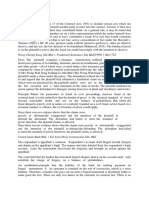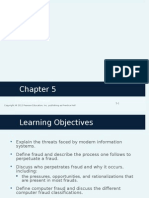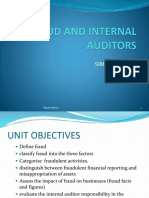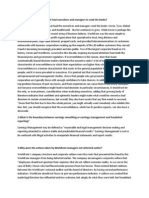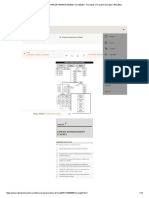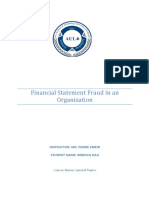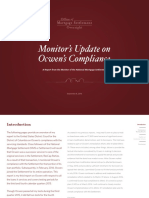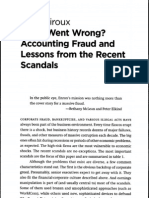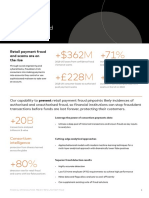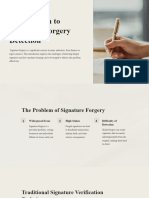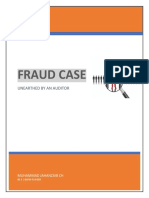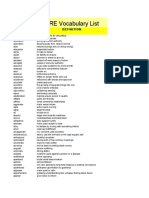Topic (4)
Fraud Tree and Fraud Schemes Properties
Submitted to:
Prof. Khaled Abd El-Monaem
Professor of Auditing, Faculty of Commerce, Cairo University
Prepared by:
Group (1)
Mennatallah Abd-elnaby
Radwa Hassan Nabih
Samar Gamal Abd elnaser
Sara Ahmed Mohamed
Andyana Ahmed
2023
1
� Table of Content
1- Introduction
2- Concept of Fraud
3- Fraud Triangle Theory and Fraud Diamond Theory
4- Fraud Pentagon Theory and its impact on Financial Statement
5- Fraud Tree
6- Fraud Schemes
2
�First: Introduction
Generally, it is important for the business organizations to identify the factors leading to
fraudulent behavior by understanding who are the fraudsters, when and why frauds are
committed. This is because, it is less expensive and more effective to prevent fraud from
happening than to detect it after occurrence. Various theories have attempted to explain the
causes of fraud and the two most cited theories are the Fraud Triangle Theory (FTT) and Fraud
Diamond Theory (FDT).
FTT theory consists of three elements that are necessary for fraud to occur: (i) perceived
pressure, (ii) opportunity, and (iii) rationalization. The former FTT has to be enhancing to
improve both fraud prevention and detection by considering an additional element above the
three, mentioned elements of FTT by adding capability as the fourth element to form FDT.
Fraud cannot successfully conceal unless the fraudster has capability: personal traits and
abilities that play a major role in whether fraud may occur even with the presence of other
three elements. Thus, FDT is an extended or improved version of the FTT with an addition of
“capability” added to the three basic elements of fraud in the FTT.
Second: Concept of Fraud
According to the Association of Certified Fraud Examiner (ACFE, 2010), occupational fraud is
the use of one’s occupation for personal enrichment through the deliberate misuse of or
misapplication of the employing organization’s resources or assets. Irrespective of the sector,
a wide category of crimes, swindles and employee trust violations fall under the category of
fraud.
According to Merriam Webster's Dictionary of Law (1996), fraud is: “Any act, expression,
omission, or concealment calculated to deceive another to his or her disadvantage,
specifically, a misrepresentation or concealment with reference to some fact material to a
transaction that is made with knowledge of its falsity.
Ernst and Young (2009) defines fraud as an act of deliberate action or mistake made by person
or group of persons who knows that the error can result in some benefits that are not either
to individuals or entities or other parties.
Third: Fraud Triangle Theory and Fraud Diamond Theory
1-Fraud Triangle Theory:
3
�In1950, Donald Cressey, a criminologist, started the study of fraud by arguing that there must
be a reason behind everything people do. It was concluded that employees who commit fraud
generally are able to do so because of the interaction between perceived pressures (usually
financial), perceived opportunity and rationalization.
1- Perceived Pressure
Perceived pressure or incentive relates to the motivation that leads to unethical behaviors.
Every fraud perpetrator faces some type of pressure to commit unethical behavior. Financial
pressure has a major impact on an employee’s motivation and is consider the most common
type of pressure. Specifically, about 95% of all cases of fraud have been influenced by
financial pressure.
Previous studies state that pressure is a significant factor in committing fraud. There are
three types of pressure which are personal, employment stress, and external pressure.
Others examine personal and corporate pressures as motivations’ proxies for fraud
commitment. Examples of perceived pressure include greed, living beyond one’s means,
large expenses or personal debt, family financial problem or health, and gambling.
The pressure/motive to commit fraud can be defined as “the source of heat for the fire” but
he believed the presence of these pressures in someone’s life does not mean he or she will
commit fraud. The pressure could be related to financial, non-financial, political and social.
Non-financial pressure can be derived from a lack of personal discipline or other weaknesses
such as gambling habit and drug addiction. On the other hand, political and social pressure
occurs when people feel they cannot appear to fail due to their status or reputation. Chen
and Elder (2007) as cited by Fazli, Mohd and muhammed (2014) identified six basic categories
for pressure including transgression of obligations, problems originated from individual
problems, corporate inversion, position achievement and relationship between employees.
Albrecht et al. (2008) categorized pressure in four groups including economic, vice, job-
related and other pressures.
In addition, pressure can be either a positive or a negative force. When goals are achievable,
pressure contributes to creativity, efficiency, and competitiveness. However, temptations for
misconduct arise when goals do not appear to be attainable by normal means, yet pressure
continues unabated, with career advancement, compensation, and even continued
employment at risk. When pressure is transformed into an obsessive determination to
achieve goals regardless of the cost, it becomes unbalanced and potentially destructive. This
is a situation where individuals are most likely to resort to questionable activities that may
eventually lead to fraud.
4
�2-Perceived Opportunity
The second necessary element for fraud to occur is perceived opportunity. Opportunity is
created by ineffective control or governance system that allows an individual to commit
organizational fraud. In the field of accounting, this is termed as internal control weaknesses.
The concept of perceived opportunity suggests that people will take advantage of
circumstances available to them. Perceived opportunity is similar to perceived pressure in
that the opportunity does not have to be real. The perpetrator must simply believe or
perceive that the opportunity exists. In most cases, the lower the risk of being caught, the
more likely it is that fraud will take place.
In addition, opportunity refers to a weakness in the system where the employee has the
power or ability to exploit the situation and, making fraud possible. Even when the pressure
is extreme, financial fraud cannot occur unless an opportunity is present. Opportunity has
two aspects: (i) the inherent susceptibility of the organization to manipulation, and (ii) the
conditions within the organization that may allow a fraud to occur.
There are 3 common proxies to measure opportunity including related party transactions,
CEO duality and difference between control and cash flow rights. The presence of related
party transactions ranks the second amongst the most frequently encountered opportunity.
Other studies used another proxy for opportunity, ineffective monitoring, which was
attributed to weak directorship in the public sector. Others suggested that CEO domination
decreases the effectiveness of board in providing accurate control over management
activities. Another proxy is organizational structure.
3-Rationalization
The third element is rationalization. This concept suggests that the perpetrator must
formulate some type of morally acceptable rationalization before engaging in unethical
behaviour. Rationalization refers to the justification that the unethical behaviour is something
other than criminal activity. If an individual cannot justify unethical actions, it is unlikely that
he or she will engage in fraud. Some examples of rationalizations of fraudulent behaviour
include “I was only borrowing the money”, “I was entitled to the money”, “I had to steal to
provide for my family”, “I was underpaid/my employer had cheated me”.
Rationalization is a justification of fraudulent behaviour because of an employee’s lack of
personal integrity, or other moral reasoning. Generally, the propensity to commit fraud
depends on people ethical values as well as on their personal circumstances.
5
�The ethical behaviour is motivated both by a person’s character and by external factors, which
include job insecurity such as during a downsizing, redundancy, a work environment that
inspires resentment such as being, passed over for promotion. Likewise, external environment
includes the tone at the top i.e. the attitude of management toward fraud risk and
management’s response to actual instances of fraud.
2-Fraud Diamond:
The FDT was first presented by Wolfe and Hermanson in the CPA Journal (December 2004).
They argued that although perceived pressure or incentive might coexist with an opportunity
to commit fraud and a rationalization for doing so, it is unlikely for fraud to take place unless
the fourth element (i.e., capability) is also present. In other words, the potential perpetrator
must have the skills and ability to commit fraud.
The elements of FDT are interrelated to the extent that an employee cannot commit fraud
until all of the elements are present. The theory proposes that pressure can cause someone to
seek opportunity, and pressure and opportunity can encourage rationalization. At the same
time, none of these two factors, alone or together, necessarily cause an individual to engage
in activities that could lead to fraud until the fraudster has the capability to do so.
1-Capability
This is the situation of having the necessary skills and abilities for the person to commit fraud.
It is where the fraudster recognised the particular fraud opportunity and ability to turn it into
reality. Position, intelligence, ego, coercion, deceit and stress, are the supporting elements of
capability. Prior literature states that not every person who possessed motivation,
opportunities, and realisation may commit fraud due to the lack of the capability to carry it
out or to conceal it. This element is particularly important when it concerns a large-scale or
long-term fraud.
6
�2-Position/Function
The person's position or function within the organization may furnish the ability to create or
exploit an opportunity for fraud not available to others. In a research conducted as An
Analysis of U.S. Public Companies, it was found that corporate CEOs were implicated in over
70 percent of publicly-company’s accounting frauds. They also report that many organizations
do not implement sufficient checks and balances to mitigate their CEO's capabilities to
influence and perpetuate frauds. Additionally, when people perform a certain function
repeatedly, such as bank reconciliations or setting up new vendor accounts, their capability to
commit fraud increases as their knowledge of the processes and controls expands over time.
3-Intelligence/Creativity and Ego
The fraudster is someone who understands and capable of exploiting internal control
weaknesses and using the position; function or authorized access to the greatest advantage.
Intelligent, experienced, creative people with a solid grasp of controls, commit many of
today’s largest frauds. According to the Association of Certified Fraud Examiners (2003), 51%
of the perpetrators of occupational fraud had at least a bachelor's degree, and 49% of the
fraudsters were over 40 years old. In addition, managers or executives committed 46% of the
frauds based on the Association’s recent study.
4-Coercion, Deceit and Stress
A successful fraudster can coerce others to commit or conceal fraud. A person with a very
persuasive personality may be able to convince others to go along with a fraud or to simply
look the other way. In addition it is noted that, a common personality type among fraudsters
is the "bully," who "makes unusual and significant demands of those who work for him or her,
cultivates fear rather than respect and consequently avoids being subject to the same rules
and procedures as others". Many financial reporting frauds are committed by subordinates
reacting to an edict from above to "make your numbers at all costs, or else.
Fourth: Fraud Pentagon theory and its impact in the Financial Statement
This theory reveals more about the factors that can detect fraud is the pentagon fraud theory.
In this theory, one other element of fraud was added, namely arrogance. Arrogance is how a
person thinks he is capable of cheating. Arrogance refers to the character of someone who
feels that he has power over everything in the company, by ignoring the internal controls that
exist in his company, developing fraud strategies that will make his personal profit.
7
�Pentagon Fraud Analysis in Detecting Potential Financial Statement
Fraudulent financial statements are unethical actions carried out consciously by a person or
group of people in a company, by providing financial information that contains elements of
falsehood so as to mislead the users of financial statements, especially investors and creditors.
There are 2 ways in which perpetrators of financial statement fraud. First, overstatement of
asset and or revenue accounts. Overstatement is the presentation of a particular account that
is higher than it really is, this is done so that the company's financial performance looks good
so that investors and creditors are more confident with the company's going concern. Second,
understatement of account liabilities and or expenses. Understatement is the presentation of
certain accounts that are lower than it really is, it aims to minimize the company's obligations
in paying state taxes or other obligations.
Fraud pentagon elements affecting financial statement fraud
1. Pressure:
The presence of pressure could lead to committing fraud. This situation can be in the form
of internal and external factors in influencing individuals to commit fraud.
The Effect of Financial Target on the Potential Financial Statement
Fraud Financial targets are monetary achievements that must be fulfilled by a manager in
one period. If the targets are achieved, management can get bonuses and high income,
and this can be achieved if they have maximum performance. The maximum performance
here can be achieved by opportunistic actions, namely, financial statement fraud.
Companies use ROA as a measurement tool to assess the performance of managers of a
company. The higher the ROA target in a company, the higher the potential for fraudulent
financial statements carried out through earnings management.
The Effect of External Pressure on the Potential of Financial Statement Fraud
External pressure is a condition where an entity gets pressure from an outside party. One
example of an external pressure that occurs in a company is when a company looks for
sources of funding to improve performance. But what is feared for every company is the
difficulty of meeting the requirements of creditors and paying off debt when they are due.
One of the conditions given by creditors is that the company must display financial
performance and is believed to be able to repay the loan. This is what drives managers to
manipulate financial statements in order to meet requirements. Leverage ratio shows how
much debt the company has to creditors. The high value of the leverage ratio shows that
the debt held by the company is of large value to creditors. This creates pressure for the
company, because it shows the risk of default is also high. So that it can create a gap for
managers to manipulate financial statements in the total debt.
8
�2. Opportunity:
Nature of industry
The nature of industry can create a gap for companies to commit fraudulent financial
statements. This is because of industry regulations that require companies to have
subjective justification capabilities in calculating estimates on certain accounts. Receivables
and inventories require subjective valuation and must be watched out because they are
often the object of manipulation of financial statement.
External monitoring
Companies that have a good monitoring system can reduce the potential for the practice of
fraudulent financial statements conducted by agents. To oversee management performance
directly, investors entrust it to the board of commissioners. The board of commissioners has
the role to oversee management in making business decisions, ensure the realization of the
company's strategy, and ensure the realization of financial accountability at the company.
3. Rationalization
Change in auditor
Rationalization is the attitudes and behaviors that arise from the mind of someone who
justifies crime, cheating and fraud he committed. Rationalization can cause someone who
initially did not have the intention to commit fraud, turned into committing such fraud and
considered it normal. Rationalization will continue to occur when there are repeated audit
failures. Audit failures can occur when there is a change of auditors in a company. The
reason, the new auditor still did not understand the overall condition of the company. So
there is fraud committed by management that is not detected by external auditors.
Therefore, management will continue to commit financial reporting fraud and consider it to
be natural because the fraud is not detected by external auditor.
4. Competence
Competence is a person's ability to commit fraud in order to realize certain goals.
Competence includes skills, knowledge, basic attitudes, and values that a person has,
reflected in their ability to think and act consistently.
Change in directors
The main factor that can be seen by the general public to judge that the person has
considerable capability is positioning. Position and function of a person in the company
could greatly affects committing fraud. Therefore, the position of top management is
considered the most reliable way to prevent or even commit fraud. Change of directors
(director change) is the delegation of duties and authority from the old board of directors to
the new board of directors with the aim to improve the performance of the previous
9
� directors. This shows that the performance of the old directors was not good/considered
unsatisfactory and could indicate fraud in the financial statements.
5. Arrogance
Frequent Number of CEO’s Picture
Arrogance is the character of someone who feels that he has power over everything in the
company. This character can cause someone to dare to commit acts of fraud because he
has the assumption that internal control and regulations imposed in the company will not
apply to him. Arrogance variables can be measured by identifying the number of CEO's
pictures displayed repeatedly in the company's annual report. CEO feels that any internal
control will not apply to him because he has a status and position. Therefore, the more
CEO photos contained in the company's annual report, the higher the potential for
fraudulent financial statements in the company.
CEO with multiple positions
Good company performance should not be related to multiple positions of directors. This
duality position allows for an increase in fraud in financial statements.
Fifth: ACFE Fraud Tree
In order to prevent fraud, detect fraud, or investigate fraud, one needs to understand as many
fraud schemes as possible.
Classification of fraud schemes:
the ACFE is emerging as the primary antifraud organization. Its only purpose is the antifraud
profession; the Association of Certified Fraud Examiners has offered a unified professional
fraud classifier, also known as “the Fraud Tree” for investigation of frauds.
1- The Association defines three key branches of the Fraud Tree:
(i)Corruption: Corruption is an attempt to gain some unjust benefit by abusing one’s official
position, or bribery of an official or a public figure.
(ii) Asset misappropriation: Misappropriation] includes the theft of assets (cash/ non cash). It
involves the misuse of any company asset for personal gain
(iii) Fraudulent reporting (financial statements fraud): a scheme in which an employee
intentionally causes a misstatement (overstatement or understatement) or omission of
material information in the organization’s financial report.
The ACFE taxonomy has been stable over time; This taxonomy number has not changed over
the years. Fraudsters find different or even new ways to carry out frauds, but most often it
is one of the old-fashioned fraud schemes used by perpetrators.
10
�2- The International Standard on Auditing 240 specifies the importance for an auditor to
examine two types of information misstatement, namely:
(i) fraudulent financial reporting, and
(ii) asset misappropriation.
Sixth: Fraud Schemes
An overview of the fraud tree schemes according to ACFE:
1- Corruption schemes:
a) conflict of interest.
b) Bribery
c) Illegal Gratuities
2- Mis- appropriation of assets:
a) Theft of cash assets
b) Theft of non-cash assets
3- Fraudulent statements:
a) Asset/ revenue Overstatement
b) Asset/ revenue Understatement
11
�First: Corruption
Corruption cases always pose a greatest challenge to the auditor. Corruption is an attempt
to gain some unjust benefit by abusing one’s official position, or bribery of an official or a
public figure. According to the ACFE 2004 Report to the Nation, corruption schemes make
up 30.1% of all frauds. Corruption schemes may take a huge variety of forms, Most
common types of corruption are bribery and conflict of interests.
Types (schemes) of corruption
a) Conflicts of Interest
A conflict of interest occurs when an employee, manager, or executive has an undisclosed
economic or personal interest in a transaction that adversely affects the company.
In schemes of conflicts of interests, managers or employees of companies have certain
personal financial or economic interests through economic operations that have most
immediate effect upon the performance of the company.
Conflicts of interest include three micro categories: purchases schemes, sales schemes,
and other schemes. The difference between conflict of interest and other corruption
frauds is the fact that fraudsters exert their influence (e.g., approving invoices or bills)
because of their personal interest rather than because of a bribe or kickback.
b) Bribery
Bribery can be defined as the offering, giving, receiving, or soliciting anything of value to
influence an official act or business decision.
12
�In an act of bribery, a person is engaged in offering, giving or taking, or intermediates in
offering, giving or taking something valuable, so that certain laws, resolutions or business
decisions would be replaced without any knowledge of certain related persons
Bribery includes three micro categories: kickbacks, bid rigging, and other.
-Kickbacks are undisclosed payments made by vendors to employees of purchasing
companies to enlist their influence in gaining business with the entity, or in allowing the
vendor to overbill.
-Bid rigging is a form of anticompetitive collusion, occurs when an employee fraudulently
assists a vendor in winning a contact involving the competitive bidding process.
c) Illegal Gratuities
Illegal gratuities are similar to bribes, but with illegal gratuities there is not necessarily an
intent to influence a business decision. For instance, a person of influence could be given
an expensive gift, free vacation, and so on for her influence in a negotiation or business
deal, but the gift is made after the deal is over. Because it is afterward, it is hard to prove.
d) Economic Extortion
Basically, economic extortion is the opposite of a bribery fraud. Instead of a vendor
offering a bribe, the employee demands payment from a vendor in order to favor the
vendor.
Second: Misappropriation of Assets Schemes:
The scheme in which the employee steals, embezzles or misuses the company's assets,
whether in cash or not, are affected by 2 schemes which include five Sub-schemes as
follows:
1- Cash misappropriation, and includes the following three sub- schemes:
• Theft of Cash on Hand: the scheme where the employee steals the cash that was
offered in the company’s treasury.
• Theft of cash receipts: employee steals cash received by the company from those who
owe to it. It is often pulled off through a technique known as skimming, where the
organization's cash is stolen before it is entered into the accounting records. This type of
theft is the most difficult to discover, since there is no internal record of the cash, or cash
is stolen after it is entered into the accounting records and is called cash larceny.
• Fraudulent disbursements is divided into:
a- Billing fraud schemes: A scheme in which a person causes the company to charge
fictitious commodity bills or inflated bills or personal bills.
b- Payroll fraud schemes: when an individual alters a payroll system to manipulate
employee compensation (e.g. paying ghost employees)
13
�c- Reimbursement fraud schemes: any scheme in which an employee makes a claim for
reimbursement of fictitious or inflated business expenses.
d- Check tampering: is a scheme of fraud that occurs when an employee alters the
company’s checks so that they can be deposited into a bank account under their control.
(e.g., forgery)
e- Point of sale fraud schemes or register disbursements: Employees may steal money as
it passes to or from a customer (through a sale or a return of goods by the customer (e.g.,
in a false refund scheme, an employee processes a transaction as if a customer were
returning merchandise, even though there is no actual return.)
2- Non- cash misappropriation (Inventory and other non -cash assets), includes the
following 2 sub- schemes:
• Misuse of assets: This occurs when an employee uses company assets inappropriately
or for personal use, it can be divided into:
a- Inventory misuse: utilizing inventory for personal use.
b- Plant and equipment misuse: inadequate supervision.
• Theft of assets (larceny): a scheme where an employee steals company’s non- cash
assets, it can be divided into:
a- Asset Requisitions and Transfers: This occurs when an employee steals the inventory
during the process when inventory to be moved internally from one location to another.
b- False sales and shipping: occur when an employee creates false sales documents and
false shipping documents to make it appear that missing inventory was not actually stolen,
but rather sold.
c- Unconcealed Larceny: This occurs when an employee takes inventory from the
company without attempting to conceal the theft in the accounting records.
Third: Financial statement fraud:
A scheme in which an employee intentionally causes a misrepresentation or omission of
material information in the company's financial reports, including two sub- schemes:
1- Net worth/net income overstatements: The employee intentionally causes distortion
or deletion of material information in the company's financial reports that help to
improperly increase the value of the company's net worth and net profit. E.g.:
• fictitious revenues,
• timing differences
• improper asset valuations and disclosures,
• concealed liabilities and expenses.
14
� 2- Net worth/net income understatements: The employee intentionally causes distortion
or deletion of material information in the company's financial reports that help to
improperly decrease the value of the company's net worth and net profit.
• Understated revenues
• Timing differences
• Overstated liabilities and expenses
• Improper asset valuations
• Improper disclosures
Silicon Valley Bank's failure
FEDERAL RESERVE RAISES RATES
Since the pandemic began, Silicon Valley Bank SIVB 0.00%increase; green up pointing
triangle had been buying lots of what are often considered “safe” assets like U.S. Treasures and
government-backed mortgage bonds. But when interest rates start to rise quickly, as they did
last year, their fixed interest payments don’t keep up with rising rates. Those assets were no
longer worth what the bank paid for them, and the bank was sitting on more than $17 billion in
potential losses on those assets as of the end of last year. Then last week, the bank faced a tidal
wave of $42 billion of deposit withdrawal requests. It wasn’t able to raise the cash it needed to
cover the outflows, which prompted regulators to step in and close the bank.
Then Federal Reserve has been raising interest rates from their record-low levels since last year
in its bid to fight inflation. Investors have less appetite for risk when the money available to
them becomes expensive due to the higher rates. This weighed on technology startups - the
primary clients of Silicon Valley Bank - because it made their investors more risk-averse.
SOME SILICON VALLEY BANK CLIENTS FACE CASH CRUNCH
As higher interest rates caused the market for initial public offerings to shut down for many
startups and made private fundraising more costly, some Silicon Valley Bank clients started
pulling money out to meet their liquidity needs. This culminated in Silicon Valley Bank
looking for ways this week to meet its customers' withdrawals.
It is hard to say what specifically causes a run; it is a matter of crowd psychology. But fears
may have emerged after the bank announced a capital raise and the sale of a large amount of
securities at a loss. The bank catered to venture capitalists and technology startups. Because
these were corporate deposits, they were often larger than the Federal Deposit Insurance
Corp.’s $250,000 insurance limit. SVB had over $150 billion in uninsured deposits as of the
end of last year.
15
�SILICON VALLEY BANK SELLS BOND PORTFOLIO AT A LOSS
To fund the redemptions, Silicon Valley Bank sold on Wednesday a $21 billion bond portfolio
consisting mostly of U.S. Treasuries. The portfolio was yielding it an average 1.79%, far below
the current 10-year Treasury yield of around 3.9%. This forced SVB to recognize a $1.8 billion
loss, which it needed to fill through a capital raise.
SVB ANNOUNCES STOCK SALE
SVB announced on Thursday it would sell $2.25 billion in common equity and preferred
convertible stock to fill its funding hole. Its shares ended trading on the day down 60%, as
investors fretted that the deposit withdrawals may push it to raise even more capital.
What happened to Signature Bank?
SVB’s problems appeared to spill over to Signature Bank, sparking its own depositors to make
big withdrawal requests. Like SVB, Signature had a relatively large amount of uninsured
deposits because of its business model catering to private companies. It probably didn’t help
that the bank was one of the largest serving cryptocurrency firms. Another crypto-focused
bank, Silver gate Capital SI 3.62%increase; green up pointing triangle, close down on March 8.
SVB Financial Group selected assets and liabilities Source: S&P Capital IQ Note: End-of-
period figures.
STOCK SALE COLLAPSES
Some SVB clients pulled their money from the bank on the advice of venture capital firms such
as Peter Thiel's Future Fund, Reuters reported. This spooked investors such as General Atlantic
that SVB had lined up for the stock sale, and the capital raising effort collapsed late on
Thursday.
SVB GOES INTO RECEIVERSHIP
SVB scrambled on Friday to find alternative funding, including through a sale of the company.
Later in the day, however, the Federal Deposit Insurance Corporation (FDIC) then announced
that SVB was shut down and placed under its receivership. The FDIC added that it would seek
to sell SVB's assets and that future dividend payments may be made to uninsured depositors.
16
�References
1-Abdullahi, R., & Mansor, N. (2015). Fraud triangle theory and fraud diamond theory.
Understanding the convergent and divergent for future research. International Journal of
Academic Research in Accounting, Finance and Management Sciences, 5(4).
2- Devi. P. N. C., Widanaputra, A. A. G. W. (2021). The Effect of Fraud Pentagon Theory
on Financial Statements: Empirical Evidence from Indonesia. Journal of Asian Finance,
Economics and Business, 8(3), 1163-1169.
3- Hidayah, E., Saptarini, G. D. (2019). Pentagon Fraud Analysis in Detecting Potential
Financial Statement Fraud of Banking Companies in Indonesia. Proceeding of The 3 rd
International Conference on Accounting, Business & Economics.
4- Information from the ACFE’s 2016 Report to the Nations on Occupational Fraud and
Abuse.
5- Vassiljev, M., & Alver, L. (2016, December). Conception and periodisation of fraud
models: Theoretical review. In 5th International Conference on Accounting, Auditing,
and Taxation (ICAAT 2016). Atlantis Press.
6- Mansor, N., & Abdullahi, R. (2015). Fraud triangle theory and fraud diamond theory.
Understanding the convergent and divergent for future research. International Journal
of Academic Research in Accounting, Finance and Management Science, 1(4), 38-45.
17






